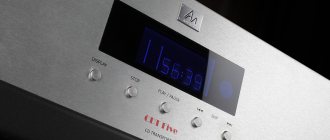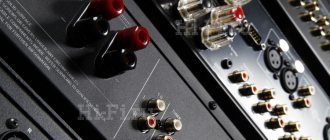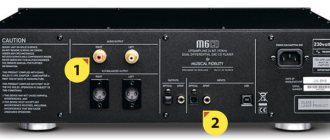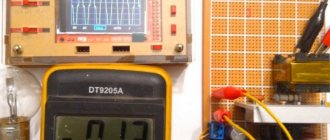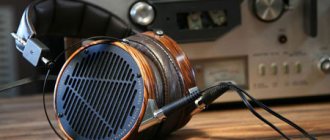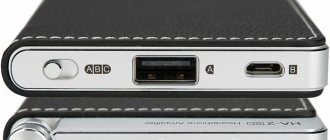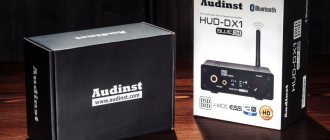Musical Fidelity M1 DAC Digital-to-Analog Converter
Recently, Musical Fidelity has released a lot of new products in a variety of price categories. And along with such monsters as, for example, components of the AMS series, several more affordable audiophile models have appeared. Their cost is reduced mainly due to design optimization with minimal compromises in terms of circuit design and component quality.
And this is true - some of the characteristics of the M1 DAC, in particular the noise and distortion levels, are even better than the flagship AMS CD player*.
* See https://www.salonav.com/arch/2011/03/052.htm.
Of course, thousandths of a percent cannot be noticed by ear, and the numbers in the passport do not always indicate sound quality. Therefore, there is no way to do without subjective tests, but before moving on to listening, a few words about our subject.
The DAC belongs to the recently released M1 line, all components of which are made in a compact “midi” format with a front panel width of 22 cm. This allows you to save not only money, but also space - on the shelf, where previously only one device of the 19-inch standard (48 .3 cm), you can put two of these. A complete set consisting of an M1 CDT transport, an M1 DAC converter, an M1 CLiC digital controller and an M1 HPA class A headphone amplifier would be a good option for individual listening.
If you store audio files on your computer, then the M1 DAC converter will be useful for decoding them. Via the USB interface, it is capable of receiving CD-Audio, mp3, WAV, AAC, FLAC files, but with a resolution not higher than 16 bit/48 kHz. For PCs running Windows 98, ME, 2000, XP, Vista and Windows7, as well as Macintoshes running OS X and Snow Leopard, no additional software is required. The signal to the DAC can also be supplied via the TosLink (optical), SPDIF (coaxial) and AES (balanced) inputs; for the last two, its parameters can reach 24/192. There is no remote control; the desired input is selected using a button on the front panel. In general, the path supports a signal with sampling frequencies of 32, 44.1, 48, 88.2, 96 and 192 kHz, and each specific value is indicated by a luminous dot on the front panel.
Traditionally, for Musical Fidelity converters, conversion is carried out by quad 24-bit delta-sigma DACs in differential mode. An incoming signal with any resolution is converted into 24/192 format and only then converted into analog form. Eightfold oversampling of the signal allows you to remove the resulting interference beyond the upper limit of the audio range. Due to this, the analog filter is significantly simplified, which always has a beneficial effect on the sound.
The output stages are built according to a balanced circuit using transistors operating in class A. Accordingly, there are also XLR analog outputs, which are also duplicated by conventional RCA.
When designing the M1 DAC, great attention was paid to power quality. In particular, alternating voltage is supplied through a balanced RF choke, which performs the function of a network conditioner.
Despite its modest dimensions, the device is quite heavy - almost 3.5 kg. The body is made and painted very carefully. The overall design is simple yet elegant.
As a transport, I used a Bryston BCD1 CD player, taking the signal from it through two outputs - coaxial and optical. In the first case, a van den Hul 3T The Rock cable was used, and in the second, a plastic Monitor Cable. I must say that the sound stage of this DAC is very dependent on the quality of the digital line, and after several sound checks I finally decided to go with coaxial. When switching to optics, the background was no worse read, but the imaginary sources in it did not always have the correct scale, and the spectral composition of the instruments was simplified.
To begin with, a quick run through the test tracks of the Burmester collection [1]. I have already mentioned several times that the DAC in the system determines not only the purity of the upper range, but also the structure of the bass. Of course, a lot depends on the acoustics, but if the lower register is not correctly formed in the source, no subwoofer is able to correct it. In our case, the bass is moderately deep, and although it is not always clear enough, especially at the very bottom, it perfectly conveys the rhythm set by the double bass or bass guitar.
If we compare the M1 DAC with the same AMS CD, the sound of which I remember very well, the difference is obvious, but the conclusions that can be drawn are not always obvious. Our much more budget-friendly DAC is in no way inferior either in energy or in sophistication of perception, it just has a different presentation. With an AMS CD, you hear a piece of music and then, if you want, you can focus on the individual instrument parts. Here the attention is drawn to fragments - you immediately notice the naturalness of the violins, the brightness and power of the brass group and many other nuances that make up the overall sound picture. Speaking of violins, due to their very complex and specific spectrum, this instrument is the most difficult for a digital source. The sound is very often blurred, i.e. timbrally simplified, or, conversely, becomes shrill and unpleasant to the ear due to the appearance of extra harmonics. For such a test, I specifically chose the perfectly recorded works of Sibelius for violin and orchestra [2]. This is where the qualifications of the M1 DAC developers came into play - their new brainchild maintains an impeccable balance between accuracy in the transmission of timbres and sound comfort. There is, as they say, both “rosin” and the masterfully performed music itself. If you can complain about anything, it’s only about the slightly sparse atmosphere of the recording due to the absence of the lightest reverberations.
The converter is distinguished by a very delicate attitude towards archival phonograms [3]. He does not exaggerate the noise of the tape and correctly conveys the outline of each musical scene, carefully built by two great artists.
Stated characteristics of Musical Fidelity M1 DAC
- 24-bit delta-sigma DACs with 8x oversampling
- Peak jitter value, ps <12
- Frequency range (-0.1 dB), Hz 10 - 20000
- Linearity (-96 dB), dB <0.1
- Channel separation (10 Hz - 20 kHz), dB >105
- Signal-to-noise ratio (A-weighted), dB >119
- Total distortion level (10 Hz - 20 kHz) <0.0025
- Output resistance, Ohm 47
- Output voltage, V
- - on RCA 2.2 sockets
- - on XLR 4.4 sockets
- Dimensions, mm 220 x 300 x 100
- Weight, kg 3.4
- price, rub. 22093
Compact format with a front panel width of 22 cm saves not only money, but also space
COMPONENTS
- Bryston BCD1 CD Player ($4,186)
- Bryston B100-SST integrated amplifier ($6787)
- Cables:
- — digital van den Hul
- — interconnect Musical Wire Cadence Revision 2 0.6 m (RUB 20,900)
- — acoustic Silent Wire LS16 LE 3 m (RUB 82,000)
- — network Silent Wire AC16 1.5 m (RUB 25,953)
- Power distributor Supra LoRad MD-06-EU Mk II/LoRad CS-EU 1.5 ($190/110).
- Vibration isolators Monitor Bolide Shock Absorber (€52), Eraudio Steel Cones ($35), Eraudio Space Harmonizer 1 ($150)
MUSIC WE LISTENED TO
- "Burmester Vorfuhrungs CD III". GEMA, 1996. A selection of compositions of various genres, recorded with exemplary quality
- Jean Sibelius, “Concerto for Violin and Orchestra in D minor, op.47.” Anne-Sophie Mutter and Staatskapelle Dresden. Deutsche Grammophon GmbH, Dresden 1995. Concerto for violin and orchestra, stunning richness of timbres
- Ella Fitzgerald & Louis Armstrong, "Ella And Louis". Verve, 1956/2000. An old soundtrack, carefully transferred from the master tape to CD
The M1 DAC strikes an impeccable balance between tonal precision and sound comfort.
share
Tags: Musical FidelityStrong Link
FX-Audio DAC M1: excellent stationary DAC with built-in headphone amplifier
After the very successful D01 model, FX-Audio decided that it was time to move on to a new generation of devices. And both in design and quality of execution. FX-Audio DAC M1, although technically repeats its predecessor, but does it on a completely different level. In terms of hardware, we are also spoiled with an excellent ESS ES9038Q2M DAC, a universal XMOS XU208 USB chip and Qualcomm Bluetooth with AptX, AptX HD and LDAC codecs on board. The power for the headphones was raised a bit, but the sound resolution was left at the current maximum: 32 bits/768 kHz. and DSD512. Of course, a very serious device. We'll talk about it today.
Content
- Characteristics
- Video version of the review
- Packaging and equipment
- Design/Ergonomics
- Parsing
- Software
- Measurements
- Sound
- conclusions
Characteristics
- DAC: ESS ES9038Q2M
- USB: XMOS XU208
- Bluetooth: 5.0, Qualcomm CSR8675 with AptX HD and LDAC
- Amplifiers: LME49720 (replaceable) + Texas Instruments OPA1612 + TPA6120A2
- Audio resolution: up to 768 kHz/32 bit, DSD512
- Headphone amplifier: 500 mW at 32 ohms
- Frequency range: 20 Hz – 20 kHz
- Inputs: bluetooth, Type C, optical, coaxial
- Outputs: linear RCA and 6.35 mm headphones.
- Power: 12 volts 1 amp
- Dimensions: 130 x 100 x 55 mm
- Weight: 350 g.
- OS: Windows, MAC OS, Android, iOS
CHECK CURRENT PRICE FOR FX-Audio DAC M1
Video version of the review
Packaging and equipment
The DAC's packaging looks much better than all previous FX-Audio models. On the front side, the manufacturer draws our attention to the presence of passed Hi-Res Audio certification, the company’s official website, and the fact that this is a new era of audio devices from this manufacturer.
Inside I found a standard set of documentation, a 12 volt 1 ampere charging unit, like the D01 model, a good meter Type C cable for connecting to a computer, an antenna and a remote control.
On the remote control, the “MUTE” button completely mutes the sound, “VOL+” and “VOL-” change the volume, and “IN” allows you to switch between inputs. The large round “OK” brings up the main menu, while the arrows allow you to navigate through it. “EQ” switches the filters built into the DAC. Of the letters below, only “A” is triggered, and it is this that binds this remote control to the device. That is, all the functionality of the DAC is in the palm of your hand, without the need to go to the device and turn anything on it.
The remote control fits comfortably in your hand, all the buttons are rubberized, and it is powered by two standard AAA batteries.
Design/Ergonomics
The body of the device is entirely made of metal and, unlike the company's old devices, has its own design. We were given the Hi-Res Audio logo on the top, and four silicone feet on the bottom for better stability on the table.
The inputs available to us are bluetooth with AptX HD and LDAC codecs, USB, optical and coaxial. There are two outputs: linear RCA and classic 6.35 mm. headphone output. Switching between them is carried out depending on whether there is something in the 6.35 connector or not. But in the settings you can set the option “play both directions simultaneously”. If you need this.
On the front part we have a small display with a brightness adjustment function and auto-shutdown, that is, you won’t have to constantly see blue light here. And this is already a huge progress, relative to even the very recent D01 model.
The button turns on the device and at the same time performs the “MUTE” function, and the large knob changes the level of the active output, and also displays the main menu. By which, by the way, we navigate and confirm our choice using the same manipulator. It rotates nicely, with slight resistance and clear mechanical clicks.
The main screen is quite informative. On it we see the current input and output, volume level and the selected filtering algorithm. Well, in the middle they tell us the type of stream and the active sampling rate. For example, PCM 44.1 kHz. For Hi-Res and DSD these values, of course, take the corresponding values.
In the menu you can select the active input, output switching algorithm, current filter, backlight level, whether to turn off the screen and the reset function to factory settings. As you can see, there is nothing superfluous.
During operation, the device heats up a little, does not take up much space on the table, looks, this time, really interesting, but most importantly, with the power increased to 500 mW, it has an absolutely clear background. With bluetooth, everything is, of course, not so ideal, but compared to D01, the progress is obvious.
Parsing
To disassemble, unscrew all the screws on the back surface of the DAC. At first it seemed to me that the board could only be pulled out to the length of the antenna or that it could already be unfastened from the back cover. But, having thought better, I realized that the back cover fits perfectly into the hole under the board, which means removing it is not difficult at all.
The components are all in place: ESS ES9038Q2M DAC, XMOS XU208 USB chip, Qualcomm CSR8675 for Bluetooth, Texas Instruments TPA6120A2 amplifier, OPA1612 and one replacement: LME49720. This, by the way, was not announced, but the news is good.
I immediately installed my favorite Burson V5i-d instead. And, in my opinion, the sound has become noticeably better.
The operating algorithm is generally simple: we connect an amplifier or active acoustics, or 6.35 mm headphones, to the RCA, and to the input is the source from which we plan to receive the signal. For bluetooth, don't forget to screw in the antenna. I use the DAC exclusively with a laptop, so I connect it via USB. Then, by long pressing the button, we turn on the device, select the input in the menu or from the remote control and that’s it, you can enjoy your favorite music.
Software
Under Windows 10, the DAC M1 was detected automatically for me, the drivers from the D01 DAC were perfect.
So we have both a full ASIO interface and WASAPI via Push and Event. In any of these cases, the sound quality will bypass the system mixer, and therefore avoid any unnecessary transformations.
The device also works perfectly with a smartphone on absolutely all applications and services. However, you can only get the most out of players that support BitPerfect. For example, HiBy Music or USB Audio Player.
Measurements
The measurements of the hero of the review, unlike D01, are simply gorgeous. Looks like they've finally learned.
Only the frequency response curve is rated “very good” due to slight attenuation at the edges of the range.
Everything else is “excellent”: noise far beyond the limits of human hearing, excellent dynamic range and distortion below minus 100 dB. Moreover, both harmonic and intermodulation.
There can be no questions here at all. Technically it's just a great device.
Sound
Before talking about the sound, I’m sure many people have a question: how, exactly, does the hero of the review differ from the cheaper FX-Audio D01 DAC? And there really is a rational grain in this. Their inputs and outputs are identical, the screen and basic functionality are similar, and even the element base is almost 100% the same. Although there is one nuance here: instead of the second replaceable LME49720, we were soldered in OPA1612. But yes, there are no other differences. I myself believe that the M1 is rather a development of the D01 in a new case, with a separate digital and analogue unit, a control panel and more advanced settings functionality. According to measurements, the M1 is, of course, better for two heads; the headphone output has also become more powerful, now it is not 400, but 500 mW at 32 ohms load. Well, the background during pauses has become, in my opinion, much cleaner. And so, of course, you can save money with the younger version.
The sound, however, is noticeably different in their presentation. In both cases it's such a fat, balanced and very natural sound, but the M1 doesn't feel as much like an analogue source anymore. There is no such softness, volume and slight defocusing of the signal. The sound here is more collected, clear, with excellent texture rendering in the lower part of the range, excellent separation of instruments and even more developed highs. In my experience, M1 is definitely more mature and better, but from a fan point of view, D01 had its own special feature with a pleasant, almost analogue character. It’s as if you don’t have a DAC, but film or vinyl. M1 gives us simply excellent transistor sound for its class. Some will classify this fact as a plus, others as a minus - everyone has different tastes. But I can say for sure that these are devices of approximately the same level and class. With a significant gap in terms of timbre development and sound technicality on the part of M1.
What did replacing LME49720 with Burson V5i-d give? The slight flakiness has gone away and the tall ones, in my opinion, have taken shape. And if in the case of the FX-Audio D01 I liked it this way and that, then for the M1 the change in op-amp is very noticeable. The low frequencies here are deep, with good dynamics and a high decay rate, the mids have good weight, depth and expressiveness, there is no special emphasis on the high DACs, carefully softening them and relegating them to the background. However, with the appropriate headphones, this range becomes simply amazing. The same Sound Rhyme SR5 really work wonders: the sound becomes sharp, clear and as technical as possible. Not at the level of Burson Playmate 2, of course, but comparable. The bunch, I tell you, is just fire. CCZ Plume, despite its bass bias, also provides very cool instrument separation and pleasant velvety highs. With the ToneKing Flame41 the DAC sounds noticeably more massive, with a more cast and darkened sound. By the way, I expected a similar character from the GS Audio SD3. But no, the overall character turned out to be bright, moderately airy and pleasantly warm. GD3B is noticeably more comfortable, with a stage that seems to be slightly compressed in width.
Yanyin Aladdin after them is like a breath of fresh air, but even in this combination there is no strong bias in micronuances, the sound is fat, timbre-rich, with good separation of instruments and slightly emphasized highs. The Yanyin Canon turned out to be just right; you can hang out with them for quite a long time. FiiO FH7 was also pleasantly surprised. It seems that the bias towards the upper frequencies perfectly complements the hero of the review, who in itself is capable of saturating the sound well with the mass and depth of the low frequencies. So the ideal recommendation would be to choose something brighter. But what surprised me most was the combination with fairly cheap KZ ZAS. I never expected such a comfortable and natural sound for their modest price. Of course, there can’t be a strong bias towards nuances with them, but everything sounds very pleasant and extremely harmonious: the lows are in moderation, the highs are present, and the middle is juicy, as if alive. The second recommendation for inexpensive headphones would be the KbEar Robin. Just as great, but with such a good bias towards nuances, purity and sharpness. If you like air and space, then you can also consider the Ikko OH1s. But this is completely an acquired taste. With acoustics, depending on the characteristics of the amplifier and the quality of the emitters, the result is similar.
In terms of genres, the FX-Audio DAC M1, in my opinion, is completely universal. I drove it for a long time and confidently on complex jazz and fast deadcore, but the device coped with everything with a bang. There is no need to talk about slow styles with a bass bias. Electronics are literally made for M1, as are ethnic music and good old black blues. The hero of the review is doing just fine with speed, fine-tuning of small nuances and tonal separation, but some headphones can hide this aspect. But, in any case, the sound of the DAC is noticeably superior to the same xDuoo XD05 Basic and the European EarMen TR-Amp. Although their presentation is aimed at speed and detail, the M1 leaves them far behind in terms of expressiveness, weight and transmission of emotions. Like the basic models from Aiyima and FX-Audio, those within $50.
The good news is that the DAC will work perfectly with all sorts of inexpensive fittings from KZ, CCA and, for example, TRN. There is plenty of everything here, except maybe tall ones, and these models are exactly tall and are able to stand out. Consequently, the harmony is expected to be decent, with well-defined depth of timbres, mass and space. Just, as they say, choose headphones.
conclusions
To sum it up, the FX-Audio DAC M1 surprised me every bit as much as the D01. And if the latter had a good analogue character, then here everything is much stricter: the presentation has become noticeably more mature, the sound is more collected and clear. At the same time, the same analog softness, richness, emotionality and simply excellent expressiveness of the sound were preserved. As for headphones, I would recommend something completely reinforced or at least hybrid. So the idyll of the connection will simply go off scale.
After D01, the hero of the review feels like obvious progress, and it was not difficult to guess about it: improved packaging, a cool new design, an advanced settings menu, convenient controls, certification, a high-quality driver, two separate boards and almost perfect measurements. All this is complemented by the ability to independently influence the sound using a replaceable operational amplifier. But this is an undocumented feature.
Among the shortcomings, the device heats up quite well. And so, everything is great. An excellent device in every sense, perhaps even more interesting than similar models from the respected SMSL and Topping. I can definitely recommend it. For the price the DAC is excellent.
CHECK CURRENT PRICE FOR FX-Audio DAC M1
This DAC now has a very bold promotional code HIFICOLLEGE3 , which gives a $40 discount.

